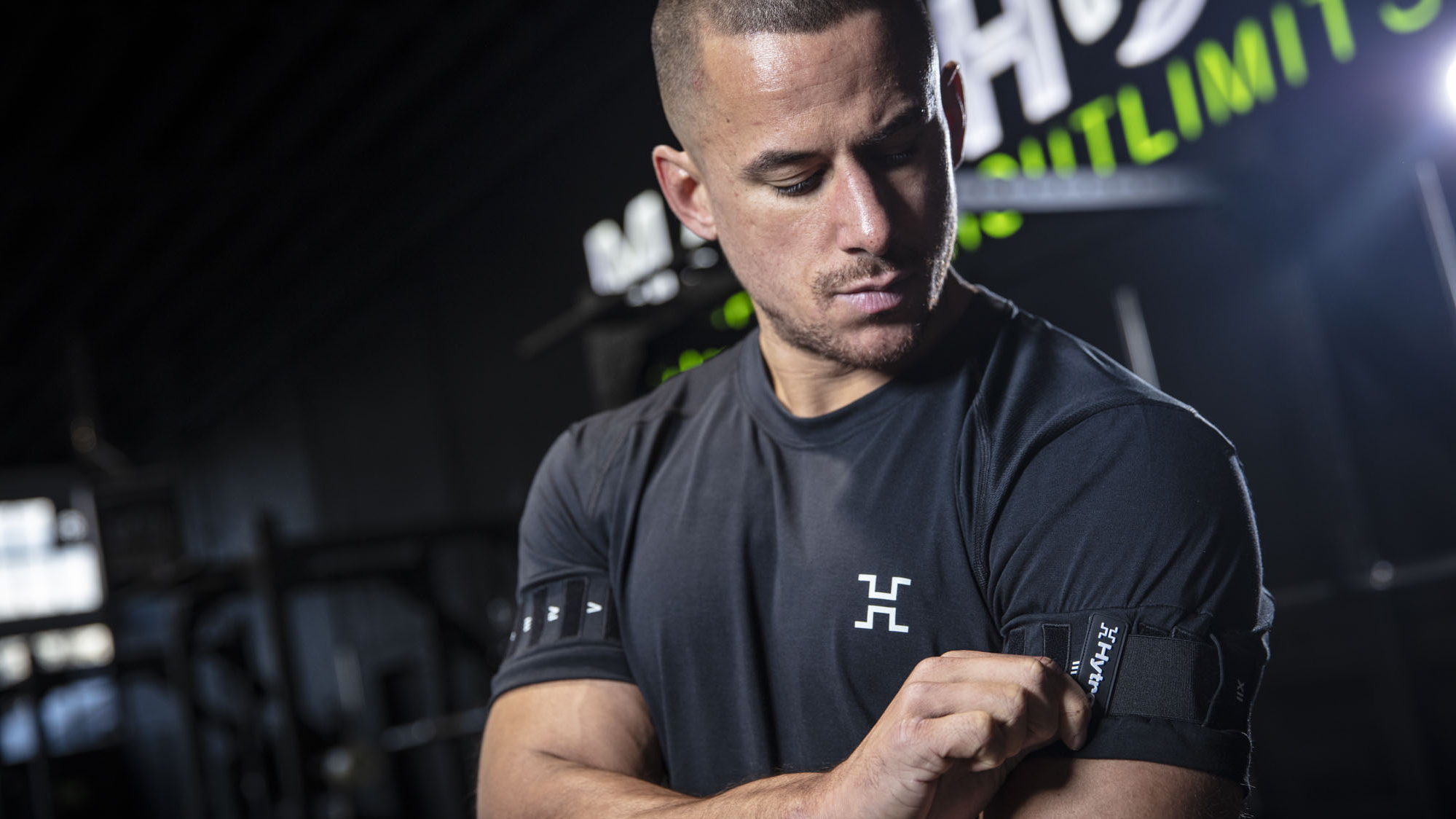

The Tokyo 2020 Olympics has been a landmark sporting event for many reasons. One of the more exciting reasons (at least for me) being that it shone a light on blood flow restriction – or BFR for short – training, a seemingly new approach for top athletes to achieve marginal gains.
It might sound new, but BFR training has been around for decades, although up until very recently, it managed to the limelight. 'Managed' is probably not the right word here, but it's true that in the past, BFR training wasn't discussed anywhere apart from hardcore bodybuilder circles. Now media outlets can't stop talking about it, including The Telegraph, CNN and even The New York Times. And yes, T3 too.
To find out more about BFR training, I sat down with Dr Warren Bradley, blood flow training expert and founder of Hytro, to talk about everything BFR, including benefits and potential drawbacks of the technology and, most importantly, what is BFR in the first place.
Dr Bradley used to work as the Performance Nutritionist for the England Rugby team a while back, and during these years, he observed BFR being used professionally for rehabilitation purposes. The technique caught his interest, and he started researching the topic to see if he could make the technology more accessible to everyday people like you and me.
"The science behind [BFR] is phenomenal. It's concrete", Dr Bradley says, "There are over fifteen hundred research papers on the topic, which is way more than you get for cupping, massage guns and different massage therapies. It's staggering", he says.
What does science say about BFR? Can an everyday person benefit from BFR training? Most importantly, what is BFR?
- You'll need some weight for BFR training, why not take a look at T3's best dumbbells guide?
- You might need some workout shoes too
What is blood flow restriction training?
For most people, blood flow restriction (BFR) could sound like a type of torture, but it's actually a training method that restricts the blood flow away from the limbs to put the muscles under more stress. You might have heard the term 'muscle under tension', BFR is 'muscle under stress'. Constant stress.
Sign up to the T3 newsletter for smarter living straight to your inbox
Get all the latest news, reviews, deals and buying guides on gorgeous tech, home and active products from the T3 experts
"Normally, your muscles are rich in oxygen: you must use oxygen to contract them", Dr Bradley explains, " What happens when you use BFR is that once you use that energy, it gets 'stuck' in the muscle so the muscle becomes deoxygenated. The muscle fibres start to say, 'whoa, this is really stressful'."
"Because of this stress, the muscles start to adapt very quickly. The fast-twitch fibres become recruited. Under normal circumstances, you only use slow-twitch fibres for slow movements such as walking, press-ups, things that don't require big muscle power. With BFR training, you also use fast-twitch fibres for these movements because the slow-twitch ones are fried. There's no oxygen left for them to contract."
"This is really impressive for pro athletes because the training they do is very intense. After a while, you can't keep adding extra sessions with heavy loads because that'll result in injuries. BFR can reduce the workload and central nervous system fatigue."

How to use blood flow restriction training?
BFR training can complement your current strength or endurance workouts, either by incorporating them in the workout or as standalone sessions.
When adding BFR to your resistance training sessions, you must do them at the end of the workout. Otherwise, you'll fatigue the muscles out before your heavy sets. What you want to do is at the end of the session, you restrict the blood flow away from the muscles – you can use Hytro's special tee, which is probably the most convenient way to go about this – and go to failure using very light weights. Hytro even has dedicated training plans which you can check out here.
BFR training can help people avoid over-training. Using BFR, you can still have a quick sesh' even on your rest days, which sounds very appealing to workout junkies such as myself. Since there is no central nervous system damage involved (in theory anyway), you can get a good pump on lighter days without completely exhausting your muscles and overworking your joints.
As Dr Bradley explains, "With standalone sessions, all you're doing is causing significant stress, which regulates the hormones responsible for muscle building. It means on a day where an athlete normally can't train, now they can actually do a five-ten-minute BFR workout and get a huge burst of muscle building hormones."
- Save money on adjustable dumbbells and kettlebells with the best Bowflex deals
Blood flow restriction training in practice
Although you 'only' restrict the blood flow away from your limbs, the process actually has a systematic effect on the body. As Dr Bradley explains, "Once you accumulated this deoxygenated blood in the limbs, saturated with hormones, as soon as you remove the strap, the whole body gets affected."
"Take, for example, the bench press. Using BFR, the triceps rapidly fatigues under stress (blood flow restricted to the limb). It becomes less able to take the load, forcing the body to recruit other muscles to take pressure off the arms. This load gets redistributed across the pecs."
"Bodybuilders are very good at understanding how to recruit certain muscle fibres over others because they are experts in the so-called 'mind-muscle connection': it promotes muscle growth. With BFR, the same thing happens to people who don't necessarily understand the process. Your body falls into an increase in fibre activation. So as well as the arms, your chest is also getting a bit of work."

Blood flow restriction for recovery
Blood flow restriction also works well for recovery.
"[BFR] creates a surge in hormones when the straps are removed; every single fibre structure and bone tendon in your body gets all of these hormones. This technique also removes waste materials faster", says Dr Bradley, "When you remove the strap, because of all the pressure in the limb, it removes the waste – bone, chipped cartilage etc. – material rapidly, flushes it out, so to say. With BFR, you can accelerate the recovery process significantly. Olympic and casual athletes alike can all benefit from this, even if they don't use BFR for every training session."
What's the catch?
Blood flow restriction training sounds too good to be true, right? It's great for strength and endurance training, recovery, everything. Why isn't it used more?
"The problem is the tools that are currently available are complicated to use", says Dr Bradley, "They're cumbersome to put on, operate and remove. They also take longer to set up, quite difficult to use and uncomfortable to wear in general."
"You'll see maybe one in a thousand people in the gym using BFR, people who are really into it. It's very niche at the moment, mainly because of the issues I mentioned earlier. It never made that leap to consumers because it's so difficult to do and integrate into training. Hytro tries to bridge this gap with its t-shirt design that allows for quick setup without sacrificing performance."
Blood flow restriction training also has a 'bad rep', partially because people don't understand the methodology and overestimate the risks involved. After all, restricting the blood flow away from the limbs sounds like a dangerous way to increase muscle mass for a non-professional athlete.
Research suggests BFR is safe and has tangible benefits, but long term research on the topic is yet to be performed. Most studies are cautious about recommending the technique, something another study summarises perfectly by saying "Although initial findings show promise, BFR training is relatively new and more research is needed to establish specific recommendations for volume, intensity, frequency, exercise selection, duration and strap pressure."

Blood flow restriction training: fitness fad or the future of resistance training?
For a person like me, someone who likes pushing their limits when it comes to resistance training, blood flow training sounds rather enticing. I can get the same results as if I were doing traditional training without overloading the muscles or damaging the nervous system. Not to mention the recovery benefits.
As Dr Bradley puts it, "Blood flow restriction training sounds impressive, but you have to experience it first hand to really understand how it works. After people give it a go, almost everyone becomes a convert straight away. You'll think, 'I can actually feel this working. I can feel the blood rushing through my body. I can feel the swell in my arms.' It's an incredible experience."
Now that the public's attention is on BFR, I'm sure we'll see even more studies conducted around the topic. Whether these studies will be in favour or against this type of training is yet to be determined. Still, as mentioned earlier, initial research suggests BFR can be a powerful training tool, especially for people who're after those sweet, sweet gains.
As for myself, I sure can't wait to give it a go.

Matt Kollat is a journalist and content creator who works for T3.com and its magazine counterpart as an Active Editor. His areas of expertise include wearables, drones, fitness equipment, nutrition and outdoor gear. He joined T3 in 2019. His byline appears in several publications, including Techradar and Fit&Well, and more. Matt also collaborated with other content creators (e.g. Garage Gym Reviews) and judged many awards, such as the European Specialist Sports Nutrition Alliance's ESSNawards. When he isn't working out, running or cycling, you'll find him roaming the countryside and trying out new podcasting and content creation equipment.
-
 Is this the beginning of the end for double-wall tents?
Is this the beginning of the end for double-wall tents?Ultralight, ultradry, ultra… shiny? Simond’s MT900 might be the smartest tent of the season
By Matt Kollat
-
 I swapped my PS5 Pro for a top-end Nvidia RTX 5070 rig – and I'm not sure I can go back
I swapped my PS5 Pro for a top-end Nvidia RTX 5070 rig – and I'm not sure I can go backPC gaming has its claws back in me
By Max Freeman-Mills